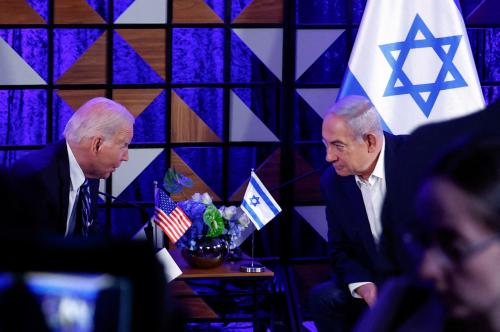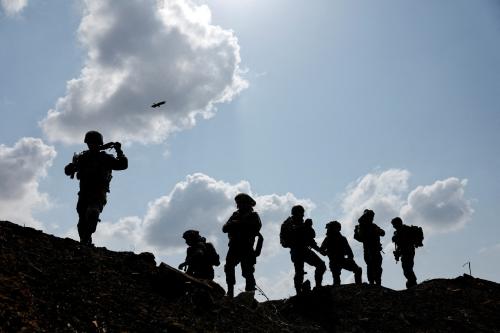Editor’s note: In testimony before the House Armed Services Committee, Michael O’Hanlon presented the case to retain a modest U.S. presence in Afghanistan beyond 2016. He pointed out that “America has shown strategic patience in this conflict” and believes we should keep it up.
Thank you Mr. Chairman, Mr. Ranking Member, and Other Distinguished Members of the Committee for the honor of testifying today on the important subject of future American policy in Afghanistan. Despite the many frustrations, high costs and casualties, occasional partisan acrimony, and imperfect results, our nation has shown remarkable patience and staying power in what has become, far and away, America’s longest war. I hope that we will not lose our patience and persistence at this late but still crucial stage.
My central argument is that the United States should not make, as its top priority, removing all combat units from Afghanistan in 2016, as President Obama now intends and much of the country appears to wish. It should seek to stay in Afghanistan indefinitely, largely for counterterrorism purposes that pertain directly to the national security of the United States. Threats from al Qaeda central and the Haqqani network (and perhaps even groups like Lashkar-e-Taiba that carried out the Mumbai attacks in 2008 and thus drove the region close to Indo-Pakistani war) are serious enough that the United States and its partners need a broad range of possible tools to counter them. Removing all combat forces would deprive us of important tools, including drones and bases for special forces, with no obvious alternatives.
Rather than emphasizing an exit strategy, we should be pursuing an enduring strategic partnership with Afghanistan. It is admittedly somewhat unconvincing to talk of victory in this war. But we should, as former Under Secretary of Defense for Policy Michele Flournoy and former Afghanistan commander General John Allen argued with me last year, be seeking to lock in, and solidify, our gains.
In 2011, when U.S. troop totals in Afghanistan were 100,000—three times the current level—President Obama announced a plan to draw them down by one third by the end of the summer of 2012. That plan was seen by many as rushed, and General Petraeus, then outgoing commander in Afghanistan, publicly acknowledged that he would have preferred a slower pace. But at least the pace of change was careful enough that, under General John Allen, the United States could execute that reduction without announcing another subsequent drawdown in the process. Not until February of 2013, after his reelection and five months after the completion of the previous troop reduction, did the president announce his next planned cuts—which were not initiated in large numbers until the fall of 2013.
Alas, in this case, while we are still drawing down current forces towards an endstate of 9,800 GIs by December, we have already announced plans for the next two rounds of cutbacks. My concern is less with that 9,800 figure than with the plan for what comes next. That total of 9,800 U.S. military personnel that will begin 2015 in Afghanistan is, as the Committee knows well, to be cut in half by year’s end, and then brought to nearly zero by the end of 2016 as Mr. Obama completes his term in office. We risk piling too many planned cuts on top of each other—even as Afghanistan’s uncertain politics and presidential transition process inject more uncertainty into the political-military situation in the country.
Thankfully it does not appear the case that the Afghan security forces will be rapidly downsized from their current strength of just over 350,000 anytime soon, as had once been proposed. The Taliban threat remains real. And the ability of Afghan auxiliary forces such as the Afghan Local Police to replace regular Afghan army and police forces is limited. (The figure of 30,000 ALP personnel, as currently envisioned by American and Afghan plans, seems a good number. But anything more is probably unrealistic given the difficulty of vetting and supervising these forces.)
Still, there are elements of administration thinking that seem harried and hurried. Instead, we need to keep our strategic patience as a nation.
A WAR TO END, OR A PARTNERSHIP TO PRESERVE?
Some may find it incredulous that President Obama’s new policy, to have all operational U.S. military forces out of Afghanistan by the end of his presidency, could be a mistake—or constitute too hasty a planned departure. Obama will have presided over eight years of American military engagement there, after President Bush’s seven and a half. The effort will be far and away America’s longest war, whether one defines the endpoint as this December’s termination of NATO’s current combat operation, or as the 2016 completion of the Enduring Force mission that will begin immediately thereafter.
The problem with this way of thinking is in the premise. We should not think about Afghanistan, at this point, as a war to end, but as a partnership to preserve. For that large majority of Americans tired of this war, and uninterested in further nation building efforts in the Hindu Kush, the best motivator might not be the modest help in airpower or intelligence that Afghan forces–already doing 95 percent of the fighting and dying in defense of their country–might still need after 2016. Rather, the best argument is a more nationalistic one about U.S. national security. Without bases in Afghanistan, from where are we going to fly drones (or stage commando raids) to monitor, target, and occasionally kill any al Qaeda that could still take sanctuary in eastern Afghanistan or western Pakistan?
Talk of U.S.-Afghan partnership may sound bizarre to many American ears. To be sure, it has been an asymmetric partnership to date, with America and its allies pumping in billions of dollars, suffering thousands of fatalities, and often being rewarded by seeming insolence from President Hamid Karzai as well as a culture of corruption within Afghanistan, high levels of poppy production, and an enduring resilience from our enemy the Taliban.
While all of these failings of the Afghanistan project are real, and serious, there are many positives to report as well, as this Committee knows. They begin, in my mind, with the above-noted tenacity and toughness of the Afghan security forces. There are enormous problems with the ANSF, to be sure, beginning with a high rate of desertion, corruption among certain commanders, and high loss rates—some 4,700 Afghan army and police forces gave their lives in defense of their nation in 2013, a tragically high figure. But that figure also demonstrates the degree to which Afghans will fight and die in defense of their country. And most Afghan cities today are relatively safe in statistical terms—compared with what they were like half a decade ago, compared with other war zones, compared even with a number of high-crime societies in places like Latin America that are supposedly at peace.
We also need to keep in mind the dramatic increases in the numbers of children in school (perhaps a tenfold increase from Taliban days, with 35 to 40 percent of today’s total girls), the growing economy (with real per capita growth rates averaging more than 5 percent a year over the last dozen years, albeit from a very low baseline), the substantial improvements in life expectancy (at least 10 years, relative to levels at the turn of the century), and the much-improved infrastructure highlighted by a nearly-complete “ring road” as well as several major arteries near key cities.
THE KOREA ANALOGY
Moreover, we have been here before in modern U.S. national security policy. Although no two cases are identical, the best analogy to where we stand now in Afghanistan may be Korea. After three years of a very frustrating conflict in the early 1950s, we secured a mediocre outcome in the form of a ceasefire that left the North Korean regime intact. And our partner in the effort was a highly corrupt, nondemocratic South Korean state that did not hold elections until the 1980s. By comparison, for all its flaws, Afghanistan is a better polity, with an electoral process underway that by later this summer is likely to replace President Karzai with a new leader via the ballot box. The two possible winners, Dr. Abdullah Abdullah and Dr. Ashraf Ghani, are both gifted men superior in integrity and competence to most early leaders of the Republic of Korea.
Yet for all of South Korea’s flaws, in 1953 we did not think of an exit strategy as the key metric of success. American national security was the crucial goal. U.S. forces settled down to a long, patient, generally nonviolent mission in helping ensure the attainment of this objective, even as South Korea remained economically and militarily weaker than its neighbor for the next two to three decades. We deployed initially more than 50,000 troops to do so, and gradually reduced that to around 40,000 in the latter Cold War decades and just under 30,000 today.
In Afghanistan, thankfully, no one is clamoring for an enduring force totaling anything close to these numbers. For all the Taliban’s resilience, it is much weaker than the North Korean regime ever was. And any al Qaeda targets we may develop in future years will likely be modest in size and number.
THE ENDURING THREAT
But as President Obama rightly observed in his West Point speech in May, global terrorism does indeed still represent the most serious acute threat to American security. Even if al Qaeda affiliates in places like Syria and Iraq and Yemen and Nigeria are now serious concerns too, the terrorist syndicate’s potential to use sanctuaries in South Asia remains considerable. Affiliates like the Haqqani network in North Waziristan (and perhaps also the Pakistani group Lashkar-e-Taiba with its ambitions of provoking Indo-Pakistani war) remain very serious worries.
Against such threats, drones remain America’s main tool for monitoring and in some cases targeting the organization. This is a group that just last fall nearly snuck a 60,000 pound bomb up to the gates of the main American military base in Khost, Afghanistan which could have killed hundreds of GIs if successfully detonated there. It also continues to send assassination teams into Kabul and will surely try to destabilize the future Afghan government. Ideologically and operationally, it is close to al Qaeda central, so any victory for the Haqqanis would be a success and a potential enabler for Zawahiri and other al Qaeda leaders who still probably live in Pakistan and who still seek sanctuaries and partners with which to attack the west.
Against this threat, there is no alternative but to have bases in eastern and southern Afghanistan–certainly at least one, ideally two or three. These facilities can be located within 50 to 200 miles of the locations we need to monitor, within practical operational range of modern unmanned systems. The plausible alternatives are not realistic alternatives at all–to operate manned or unmanned aircraft from carriers in the Indian Ocean, more than five hundred miles away.
For all our successes against al Qaeda in recent years and the associated decline in the recent rate of drone strikes, there is no way to predict that this threat will simply disappear in 2016 to fit with Mr. Obama’s preferred storyline that he will have ended two wars on his watch in the White House. And while Americans say they would like this war to be over, the intensity of that sentiment is muted—probably because they want even more to be safe. As such, policymakers can and should do what is right for American national security, without worrying excessively about political pressure.
CONCLUSION
Yes, retaining perhaps 3,000 U.S. personnel in Afghanistan for five or ten or even twenty years after 2016 could cost DoD some $5 billion a year, on top of the $3 billion to $4 billion in U.S. economic and security assistance to Afghanistan that is also needed. An enduring presence could occasionally involve modest numbers of American casualties, too. But that is perhaps an unavoidable cost in the age of terror—or, to be more exact, it is a lower cost than the country could suffer in terms of a future attack, if we do not remain vigilant and engaged. And compared with our recent mission costs of more than $100 billion a year and several hundred fatalities, or the overall defense budget exceeding $500 billion annually, it is not an extremely high price. Even if sustained for another full decade, it would add some 10 percent to our total financial cost of this war, for example.
America has shown strategic patience in this conflict. Congress has contributed to this patience, for which it deserves considerable credit. I believe we should all keep it up. The stakes are still high, and the threat is still real—but so is the opportunity to lock in important gains that we, together with many allies and our Afghan partners, have achieved over the last thirteen years, and to retain counterterrorism tools that we may still need for years to come.



Commentary
TestimonyThe Case Against the 2016 Zero Option for Afghanistan
July 30, 2014